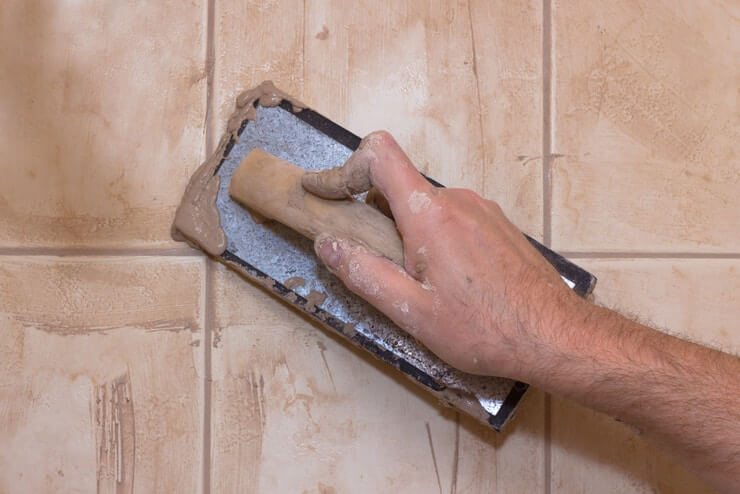Cement-based grout can take anywhere from 48 to 72 hours to fully cure, while epoxy grout can fully dry in 24 hours. If a sealant is required, you should wait an additional 24 hours before using your shower. In any case, follow the manufacturer’s instructions and recommendations.
When grouting a bathroom, whether you’re doing a remodel, new construction, or some long overdue shower maintenance, the question asked most often is how long does the grout take to dry? Unfortunately, grout curing times vary, so it is best to consult the instructions that came with the grout product you purchased.
Getting your grout wet before it is dry can have adverse effects, which we will outline below. This article will also cover the factors that impact grout drying times along with ways to reduce the drying or curing time of grout.

What Happens if You Take a Shower With Unsealed Grout?
Taking a shower before you seal your grout is never a good idea, with the exception of epoxy-based grouts that do not need sealant. But when it comes to the more common cement-based grout, getting it wet before it is sealed can cause some serious issues.
Water Damage
Getting grout wet before it is sealed can ultimately defeat the purpose of having it. Grout not only bonds tiles together and fills the empty space between them but also keeps those gaps waterproof. By getting your grout wet before it is cured and sealed, you run the risk of allowing water to penetrate these gaps causing mold or water damage.
Poor Appearance
When a cement-based grout gets wet before it is sealed and cured, it can develop a dreadful appearance. Water can cause your unsealed grout to become runny and develop cracks. Water can also cause your grout to become discolored. These appearance issues can also be brought on by improper mixing.
Extra Work
The possible water damage and cracked or runny grout caused by taking a shower before your grout is sealed will force you to re-do the entire job. This will not only take extra time and work but comes with an additional cost of having to purchase more grout.
Factors That Impact the Drying Times of Grout
Type of Grout
Cementitious Grout
Cement-based grouts are easier to apply than epoxy-based grouts but take longer to cure. Cement grout can take up to three days to cure, which can be 48 hours longer than epoxy-based grout. However, cement grout is less expensive and easier to install than epoxy. There are also sanded and un-sanded varieties of concrete grout that have slightly different drying times.
Epoxy Grout
While more challenging to install, epoxy-based grout has a much quicker cure time when compared to cement-based grout. Most epoxy grout will fully dry within 24 hours. Epoxy grout costs more but lasts longer and is easier to maintain than cement-based alternatives. Epoxy grout is usually used for more commercial or industrial applications but can be used in your home as well.
Humidity Levels
Humidity is the concentration of water vapor in the air. Bathrooms and kitchens are usually the most humid rooms in your home. Humidity will have a direct impact on your grout’s drying timeframe.
If your bathroom has high humidity or more moisture in the air, your grout will take longer to dry. On the other hand, low humidity can reduce your grout’s drying time.
Extremely high humidity is a concern as it can extend your grout’s drying period beyond what the manufacturer recommends.
Tips on How to Reduce the Drying Time of Grout
Curing is a natural process that takes time. But these tips can help ensure your grout drying time does not take longer than it should.
Use a Fan
A rotating fan placed in your bathroom can help distribute air across your floors and walls, which can help your grout dry. A stationary fan can help, but it will not work as well as a rotating fan. Your bathrooms exhaust fan can help with humidity as it pulls air out of your bathroom. For best results, leave a rotating fan on overnight.
Remove Plants From the Room
All plants create oxygen, and certain plants like lilies actually release moisture into the air. So by removing plants from the equation, you have more control over the air in your bathroom, which helps your grout dry.
Protect Your Grout From Exposure
If you are installing grout in an unfinished home that is exposed to the elements, you should protect your grout. The sun, rain, and snow can all have a considerable impact on your grout’s drying period and the quality of your installation. Using a tarp or other protective material can save you from headaches down the road.
Be Mindful of Humidity
When it comes to waiting for your grout to dry, humidity can be your worst enemy. Most portable thermostats will give you humidity readings. You can also buy a specialized humidity reader. A humidity level between 40% to 60% is excellent for curing, while any reading over %70 will increase your drying time.
Use an Air Conditioner or Dehumidifier
Unlike a fan that distributes air using a dehumidifier or air conditioning will keep your air dry. This is an excellent method to employ if the humidity in your bathroom is too high. Dry air helps control moisture and keep your grout drying time where it should be.

